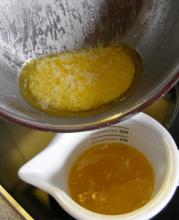Ghee is a Sanskrit word for a clarified butter used primarily in Indian cuisine. Because the preparation of ghee involves heat, it has a distinctive toasted flavor, often described as nutty. Before the advent of commercial vegetable oils, ghee was widely used for deep frying. Unlike other butter-based products, ghee has a high smoking point and can be stored without refrigeration for weeks. As long as ghee is stored in air-tight containers, it does not spoil easily.
Link:
Traditional ghee is produced from the milk of buffalo indigenous to the regions of India and Pakistan, but it can also be made from any other milk-producing animal. The process begins with the standard butter created through the churning of milk fats, solids and water. This butter still contains a significant amount of moisture, which must be boiled off to create a clarified butter.
Sticks of pure butter are placed in a large saucepan or kettle over medium to high heat. As the butter melts, it begins to boil. The solids settle to the bottom, while a thicker layer of oil forms in the center. The excess water forms a foamy top layer as it boils away.


